- Video Production
- Video Production Equipment for Beginners
- How Does a Drone Work
How Does a Drone Work? Learn Flight Mechanics and Camera Tech
How does a drone work in simple terms?
Key Takeaways: How Does a Drone Work for Beginners?
What is a Drone?
- A drone, or unmanned aerial vehicle (UAV), is a remotely controlled or autonomous flying machine, often used for video production, surveillance, and more.
- Popular among civilians, the quadcopter (a drone with four propellers) is widely used for aerial photography and videography.
How Drones Work
- Drones fly using propellers, motors, and a flight controller (the "brain" of the drone) that stabilizes and navigates the device.
- They use GPS and obstacle avoidance technology to move accurately and safely through space.
- Drones can capture high-resolution videos and images, offering unique aerial perspectives.
Advantages of Drones in Video Production
- Engaging: Drones provide captivating aerial shots that are visually compelling.
- Low-Cost: A more affordable alternative to helicopters for aerial filming.
- Easy to Use: User-friendly controls make drones accessible to beginners.
- Versatile: Drones can navigate tight spaces, fly low, and capture dynamic shots.
- Practical: Used in filmmaking, journalism, rescue operations, and even for creative selfies.
Key Components of a Drone
- Propellers and Motors: Generate lift and movement.
- Flight Controller: Acts as the drone’s brain, using sensors like gyroscopes and accelerometers to stabilize and navigate.
- Gimbal and Camera: Ensures smooth, stable footage and allows for high-quality video and photo capture.
Drone Regulations
- Drone usage is subject to laws and regulations, which vary by country.
- In the U.S., commercial drone operators require a Part 107 certificate, while recreational users must register their drones with the FAA.
- Always check local airspace rules and fly in safe, open areas to avoid accidents.
History and Evolution of Drones
- Drones originated in military applications but have since become popular for civilian use.
- Key milestones include the introduction of consumer-friendly drones in 2010 and the rise of camera-equipped drones like DJI’s Phantom series in 2013.
Why Drones Matter
- Drones offer a unique blend of technology, creativity, and practicality, making them invaluable tools for video production, photography, and beyond.
- They enable users to capture stunning visuals, explore new perspectives, and perform tasks more efficiently and safely.
What exactly is a drone? What are its capabilities? How can it enhance our video production process? And what legal considerations should we keep in mind when flying one?
Let’s explore these questions and more as we dive into the world of drones and their role in filmmaking.
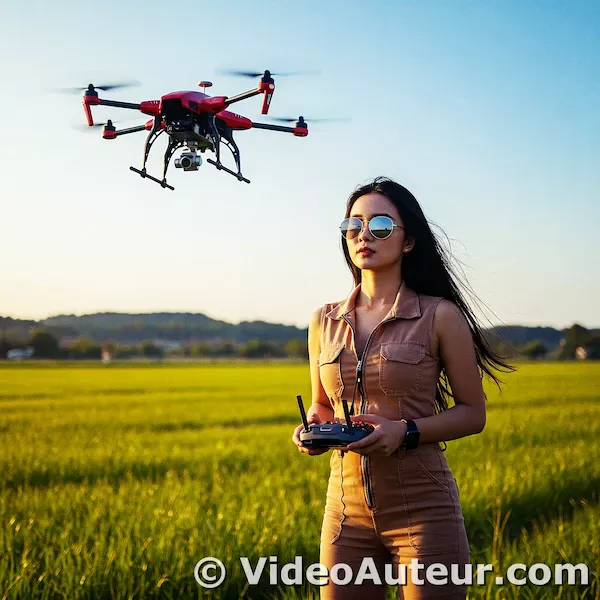
Video Key Takeaways: How do drones work?

How Drones Work (For Beginners):
- Quadcopter Design is Key: Most drones use four propellers (quadcopter). By precisely adjusting the speed of each spinning propeller, the drone can hover, move up/down, tilt (pitch/roll), or turn (yaw). This design provides essential stability.
- The "Brain" and Senses: A flight controller acts as the drone's brain. It constantly reads data from sensors (like accelerometers, gyroscopes, and often GPS) to understand its position, tilt, and movement.
- Staying Stable and Controlled: Using this sensor data, the flight controller instantly adjusts the speed of the four motors. This automatic correction keeps the drone stable in the air and allows you to control its movements smoothly, even in wind.
- Power and Connection: Lithium-ion batteries power everything. You control the drone via radio signals (like your controller). If the signal is lost, GPS often helps it fly back to you automatically.
Why this matters for your videos: This combination of smart electronics, sensors, and motors is what makes drones stable enough to capture smooth, cinematic footage, even when you're just learning to fly.
Companies like DJI excel at refining this tech.
Key points in the video include...
Drone Design Evolution:
- Single Propeller Drone: Basic design with limited control, only capable of vertical movement. Suffers from body rotation due to "Newton's third law".
- Two Propeller Drone: Improved stability by counter-rotating propellers to cancel reaction torque. However, challenges remain in achieving high-speed control and stability.
- Three Propeller Drone: Rarely used due to complications with reaction torque and gyroscopic precision.
- Quadcopter (Four Propeller Drone): Most stable and widely used. Achieves maneuvers (pitch, roll, yaw) by adjusting propeller speeds and balancing forces.
Flight Control and Sensors:
- Flight Controller: Acts as the "brain" of the drone, enabling precise control and stability. It processes input from various sensors to make real-time adjustments.
- Sensors:
- IMU (Inertial Measurement Unit): Combines accelerometers, gyroscopes, and magnetometers to measure acceleration, rotation, and orientation.
- MEMS Technology: Used to create tiny, accurate sensors.
- Sensor Fusion: Combines data from multiple sensors (e.g., GPS, IMU, radar) to improve accuracy and reliability.
Control Algorithms:
- Kalman Filter: A key algorithm used for navigation, stabilization, and error reduction. It processes past and present data to make smart decisions, such as controlling motor speeds for stability.
- BLDC Motors: Brushless DC motors are controlled intelligently to handle challenging environments.
Industry Leaders:
- DJI: A leading company in consumer drones, known for advanced flight control algorithms, dual IMUs, and vibration dampening systems.
- Other companies like Parrot, Autel, and Yuneec lag behind in refinement and advanced features.
Power and Communication:
- Lithium-ion Batteries: Power the drone's motors, electronics, and sensors.
- Communication: Uses radio frequency technology for control signals. If the drone goes out of range, GPS and internet technology help it return to a pre-set home location.
Additional Insights from the Video:
- Quadcopters are the most stable and versatile drone design, making them ideal for various industries.
- Flight controllers and sensor fusion are critical for real-time stability and navigation, especially in challenging conditions like wind gusts.
- Advanced algorithms like the Kalman Filter play a crucial role in error reduction and decision-making.
- DJI leads the market due to its sophisticated algorithms and reliable hardware, setting a benchmark for competitors.
- Sensor accuracy and noise reduction are vital for precise drone operation, achieved through MEMS technology and sensor fusion.
- Communication and GPS integration ensure drones can return home safely if they lose connection with the operator.
As you can see, this video gives you a bird's eye view of drone technology, highlighting the importance of design, sensors, algorithms, and industry advancements.
What is a drone?
A drone (or UAV) is a pilotless flying robot you control remotely. The most common type for video is the quadcopter (with 4 propellers), which lets you capture stunning aerial footage easily using a simple controller, much like a video game.
Key points for beginners:
- Pilotless Robot: It flies without anyone on board.
- Remote Control: You fly it from the ground.
- Quadcopter = Video Drone: This is the standard, accessible design for aerial filming.
- Easy to Use: Designed with user-friendly controls for beginners.
- Core Purpose (for you): Capturing aerial video from unique perspectives.
A drone is an aircraft that you can…
- remotely control, or
- launch so that it flies autonomously—meaning, without you always controlling it.
You may view it as a robot that can fly, without a human pilot on board.
—
The formal term for the drone is, “unmanned aerial vehicle” (or, UAV).
The only reason, this intelligent machine can fly autonomously is this—a human on the ground has programmed flight plans, in the drone's system. So, it is still... Humans over machines.
Moreover, drones have a long relationship with the military. But drones have also found their way, and usefulness to civilians.
—
This unmanned aerial vehicle is both complex and simple.
"Complex"... because a drone is the result of putting together very technical things—including computer, artificial intelligence, physics, camera, etc.
"Simple"... because a civilian—or, an everyday person—who uses a drone, finds that its user interface is relatively plain. It feels like you’re just using a video game controller. Not manipulating a jet plane's control panel.
A hobbyist commonly uses a drone called, "the quadcopter".
What is a quadcopter?
A quadcopter is a popular type of drone with four propellers, commonly used for capturing aerial video.
We often see those little flying drones with four propellers. Those are called quadcopters, basically like helicopters with four rotors instead of just one. That's why you might also hear them called "quadrotors" for short.
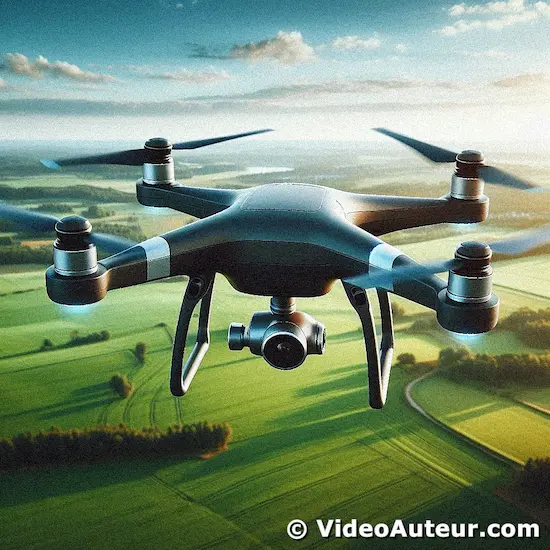 How does a drone work--particularly the quadcopter, which is accessible to everyday people? Keep on reading...
How does a drone work--particularly the quadcopter, which is accessible to everyday people? Keep on reading...It is a form of drone, or UAV, that is popular among ordinary people who love to shoot videos from above.
Why is it called a drone?
It's called a drone primarily for two connected reasons:
- Bee Origins: The word "drone" originally meant a male honeybee, known for its monotonous buzzing sound.
- Military History and Sound: In 1935, the British named a remote-controlled target aircraft the "Queen Bee." This naturally led to similar unpiloted aircraft being called "drones," reinforced by the buzzing sound their engines made – just like the bees.
So, for your video production hobby:
- The name comes from the buzzing sound of the aircraft (like a bee) and a historical link to the "Queen Bee" target drone.
- Today, "drone" is the common, casual term for the quadcopters you fly to capture video. "UAV" (Unmanned Aerial Vehicle) is a more formal synonym.
You might be surprised, but "drone" used to have a different meaning.
"Drone" originally meant a male honeybee…
- That doesn’t have a sting.
- That doesn’t work to get pollen or nectar.
- That only mates with the queen bee.
"Drone" also meant a monotonous buzzing, or humming sound. Just like what you can hear from the bees.
—
The British used a radio-controlled aircraft, called “Queen Bee”, sometime in 1935. It's an unpiloted flying machine, used as object for target practice.
Somehow, the name “Queen Bee” led to the use of “drone” to also mean…
… an aircraft without a pilot on board.
—
And think about it...
A typical drone we fly nowadays, really sound like the buzzing of a bee—or “drone”. This may have stimulated people to give “drone” a different meaning.
Today, people say “drone” and “unmanned aerial vehicle”. And they mean the same thing.
—
Most folks you hear using "drone" though, they're probably talking about those cool quadcopters hobbyists love to fly.
But, when we hear “UAV” or “unmanned aerial vehicle”, we sense some formality in the term. It feels like, “UAV” is more associated with drones used by government.
Also, some say DRONE is an acronym—which stands for “Dynamic Remotely Operated Navigation Equipment”.
Who invented the drone?
Abraham Karem is credited as the key inventor of modern military drones, specifically the famous "Predator" drone (1996).
Key points for beginners:
- Key Person: Abraham Karem, an aerospace engineer.
- Key Invention: He developed the "Predator" drone, a landmark military UAV (Unmanned Aerial Vehicle).
- Not Quadcopters: His early drones (Albatross, Amber, Predator) had fixed wings like airplanes, not the multi-rotor (quadcopter) design common in consumer video drones today.
- Military Origin: The text below focuses on the invention of military drones, which preceded the consumer drones used in video production.
In short: While consumer quadcopters evolved later, Abraham Karem is recognized as the "godfather" of modern drones for inventing the pivotal Predator military drone.
Have you heard of Abraham Karem? This aerospace engineer is basically the godfather of drones!
Born in Baghdad in 1937, he grew up in Israel after his family moved there in 1951. There, he graduated from Technion – Israel Institute of Technology, as an aeronautical engineer.
Abraham relocated to US, in the 70s, where he built “Albatross”—his first drone.
His undying love for aeronautics, enabled him to make a better drone called, “Amber”.
Later on, “Amber” became Abraham’s basis for developing the “Predator” drone.
—
Know that the early forms of drone Abraham made, were not yet quadcopters. Instead, they were drones having fixed wings—like the “Predator” drone.
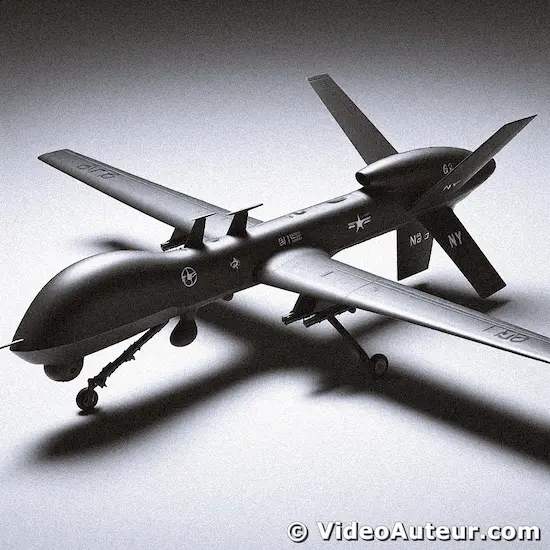
So, you may ask, Who invented the quadcopter drone specifically?
Who invented quadcopter drone?
There isn't one single inventor. Quadcopter drones evolved through continuous improvements by many people over time.

To answer that, consider that there those who are trying to constantly improve, and evolve this unmanned aerial vehicle. So, there are several sources of drones.
And it’s hard to say, who the real inventor of the quadcopter drone is. But our takeaway is this...
Technology progresses, because humans have the insatiable hunger to create or invent.
Machines that we know today—like quadcopter drones—are likely to get even better, and more sophisticated in the future.
When was drone invented?
The first modern drone is widely considered to be the "Queen Bee," invented in 1935.
Key points for beginners:
- The Very First (Modern Concept): The "Queen Bee" (1935) is recognized as the first successful, reusable modern drone.
- A Famous Military Drone: The armed "Predator" drone (invented by Abraham Karem and produced in 1996) is a much later, famous military development.
- Civilian Drones Came Later: The text below highlights that the drones you likely use for video (small, camera-equipped, civilian) appeared significantly later than these early military models (1935 and 1996).
In short: The core idea of a modern drone dates back to 1935.
Inventor Abraham Karem is most known for the “Predator” drone. It’s because this UAV carried weapons. It’s a warfare drone.
He and the United States, produced the “Predator”, in 1996.
—
However, some say that the first UAV existed earlier than 1996. And that's the “Queen Bee”—which others consider to be the first modern drone. It appeared in 1935.
—
Now, notice that we’ve been talking about military drones. But how about drones that civilians and ordinary people use?
What are the key moments in the history of drones that led to their use by civilians and everyday people?
- 2010: Smartphone Control (Parrot AR Drone): Drones became much easier and cheaper to fly using apps on your phone, making them accessible to regular people.
- 2013: Popular Built-in Cameras (DJI Phantom): High-quality, easy-to-use drones with integrated cameras sparked massive interest. This is when aerial videography truly took off for enthusiasts and creators.
Why this matters for you: These moments directly led to the affordable, easy-to-use camera drones available today, allowing students and self-learners to capture professional aerial footage without needing military-grade tech or pilot licenses.
The DJI Phantom series, in particular, revolutionized creative video possibilities.
Well, there are few important milestones in history, regarding drones for civilian and consumer use…
- In 2006, US Government permitted the use of drones, to help in rescue and relief operations.
Drones with thermal cameras aided in search operations—by reading the heat signatures of people from afar, who needed to be rescued.
Also, many companies were developing drones, to better suit the needs of consumers and businesses, near this period of time.
- In 2010, smartphones gained the capacity to control drones.
Parrot—a French drone maker—released the small quadcopter drone for the consumer. You just needed an app on your smartphone, to fly that thing.
- In 2013, consumers became strongly interested in drones, with built-in cameras.
It's when DJI company brought out their Phantom drone series. Many video enthusiasts, then, set out to fly their drones, to capture aerial shots.
What exactly does a drone do?
Drones capture stunning high-resolution photos and videos from unique aerial perspectives, giving you amazing overhead shots that would be difficult or impossible to get otherwise.
They can shoot in HD (1080p) or UHD (4K), and some advanced models even capture infrared footage for night scenes.
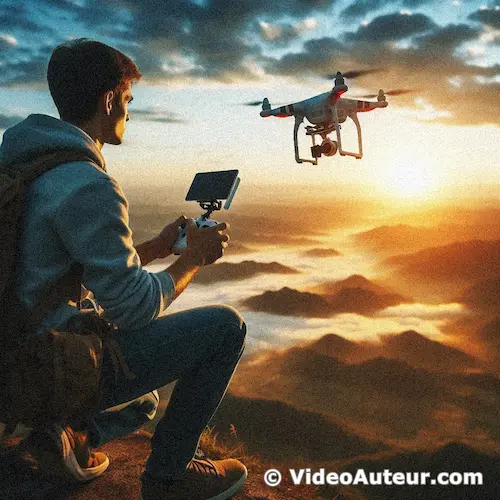
Or what are drones capable of?
- A drone can fly at different distances.
- Drones can sense their surroundings and calculate how they'll move in space.
- Drones can reach locations accurately.
- Drones can capture high resolution videos, and very detailed images—giving you beautiful and amazing perspectives from above.
- Drones can help humans do things more efficiently, and safely.
Now, let's discuss them one by one...
1. A drone can fly at different distances.
Even a hobby drone can go as far as 3 miles away, from the person who controls it.
But, a more advanced drone can travel beyond that. It can hover so high above the land, that people underneath that drone couldn't easily notice it.
2. Drones can sense their surroundings, and calculate how they'll move in space.
Therefore, they can avoid obstacles.
To do that, drones use some obstacle avoidance technology. They use sensors and detectors, that enable them to pass through tight spaces... safely.
3. Drones can reach locations accurately.
They’re able to do that, with the help of Global Positioning System—or, GPS—and the programmed flights, set by the drone operator.
4. Drones can capture high resolution videos, and very detailed images—giving you beautiful and amazing perspectives from above.
Depending on a drone’s model, it can shoot high definition—or, HD—videos, like 1080p. Other models can shoot ultra high definition—or, UHD—videos, like 4K.
More advanced UAVs even use infrared, that’s useful for shooting at night, and for detecting heat that humans and objects give off.
5. Drones can help humans do things more efficiently, and safely.
Because of drone’s capabilities—which become better and more powerful, as technology progresses—humans have found excellent uses of drones.
Don't think drones are just for fancy military stuff anymore. They've become really popular for fun stuff too, like taking amazing videos and photos for vacations or even making movies.
Drones help even in surveillance, rescue, and giving public service announcements—for instance, during pandemic.
What are the advantages of using drones, particularly in the context of video production?
- Unique and Engaging Perspectives: Capture stunning aerial shots (like a bird's-eye view) that are impossible with ground cameras, making your videos more visually compelling for audiences. Filming itself is also exciting!
- Low Cost: Drone aerial footage is dramatically cheaper than renting helicopters or planes, making professional-looking shots accessible for students, self-learners, and indie creators.
- Ease of Use and Efficiency: Modern drones are designed to be relatively easy for beginners to learn to fly and operate. They allow you to get complex shots (like sweeping establishing shots) quickly and with less physical effort than traditional methods.
- Versatility in Movement: Drones can fly very low, navigate tight spaces, and move in ways larger aircraft can't, enabling creative shots like low-angle tracking shots or flying through obstacles.
- Practical Creative Tool: Drones are widely used in filmmaking, journalism, photography, and even fun projects (like dynamic video selfies), offering endless creative possibilities to express your vision.
In short for beginners: Drones let you capture amazing, professional-looking aerial shots easily and affordably, opening up creative possibilities and unique perspectives that make your videos stand out.
Here are some key benefits of using drones in shooting videos...
- Engaging.
- Low-cost.
- Easy and efficient to use.
- Versatile.
- Practical in many ways.
Now, let's discuss these advantages one by one...
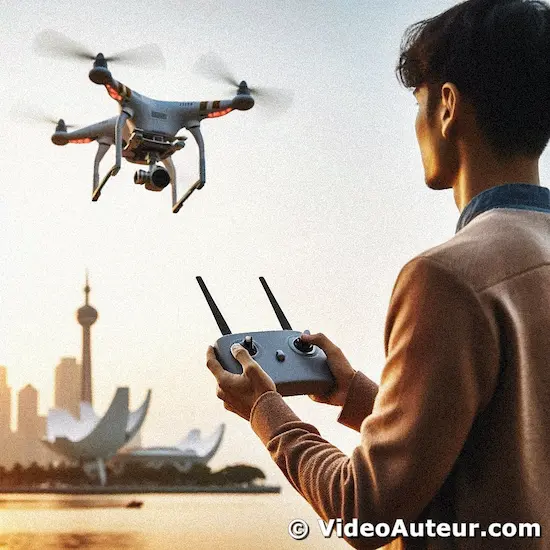 How does a drone work, when you're taking aerial shots of your subject?
How does a drone work, when you're taking aerial shots of your subject?Engaging.
Using a drone, and viewing the output of using it, are both engaging.
As humans, we love to see how birds see the world, from high above. We want to experience that unique viewpoint.
Shooting a drone video is engaging. That feel of piloting an aircraft in space, while you're standing on the ground, is unique. You get to see things, you don’t normally see in your everyday life.
And the resulting video is compelling to watch. Drone footage—like aerial shots of happenings on the ground—can really engage you and your audience.
Low-cost.
Shooting videos using a drone is very cheap, compared to renting a helicopter to film aerial shots.
Big film studios can afford costly helicopter, or airplane shots.
But for indie film makers, amateurs, and beginners, that highly sought-after aerial video, is more doable with a drone. It's a low-cost solution to recording aerial shots.
Easy and efficient to use.
A drone may be an advanced tool. But an everyday person can still find it easy to learn to operate. In fact, more and more civilians are owning and using drones, for video making.
One motivation to learn how to fly a drone, is the efficiency it brings. It does the job in less time, with lesser effort. How easy it is, to get an establishing shot with a drone?
Versatile.
- A drone is more versatile in navigating space, than a helicopter and other manned aircraft. Therefore, it's more helpful in videography.
- A drone is small enough to move through a tight space, while recording video.
A drone can fly so low, just above the ground. So you can get that fascinating, low-angle tracking shot.
Practical in many ways.
The drone has applications in military, non-military, and creative fields. Here's some examples…
1. Military-related use: war coverage
We’re not going to talk about drones for warfare—those that carry weapons, like missiles.
We’re just talking about using drones, to record videos of war happenings—that is, war reporting. With drones, journalists can safely cover a war, without risking their own lives, just to get close to the action.
2. Non-military use: filmmaking
Some filmmakers use drones, as tools for expressing their visions. Drones enable them to show their viewers, alternative viewpoints of this world.
3. Non-military use: journalism
“Drone journalism” now exists.
Drones can provide aerial footage for news agencies, and TV programs. A sample footage is a live video feed from a drone, covering the traffic situation in an area.
4. Non-military use: aerial photography
You can also use a drone to take aerial photographs. And you may want to use those photographs, in two ways…
- as stand-alone photographs—This is your collection of creative photos.
- as still images you'll incorporate into your video—This is part of your multimedia approach to creating audio-visual presentations.
5. Fun, clever use: drone video selfie
Who doesn’t know what a selfie is? ;-)
With a drone, you can get video selfies—alone, or with family and friends.
One obvious difference is you’re not going to use a selfie stick. Instead, you'll use the joysticks of your drone’s remote controller.
How does a drone work in a video shoot?
A drone works for video shoots by combining 3 key capabilities:
- Autonomous Flight: It flies using propellers powered by motors, controlled wirelessly via a remote (often with a smartphone). GPS and internal sensors (like gyroscopes) help it hover steadily, follow pre-set paths, and stay balanced with minimal constant manual input.
- Stable Shots: A built-in 3-axis gimbal uses motors and sensors to actively counteract the drone's movements and vibrations. This keeps the camera incredibly steady in the air, delivering smooth, cinematic footage like a floating camera operator.
- Remote Camera Control: An integrated camera is controlled directly from your remote. You see a live video feed on your smartphone screen, frame your shots, start/stop recording, take photos, and often adjust settings (like exposure) without touching the drone itself.
In short: You fly it remotely, the gimbal keeps the shot rock-steady, and you control the camera and see what it sees live from the ground – making complex aerial videography accessible.
Beginner Tip: Always check local drone regulations and fly in open, safe areas before your shoot!
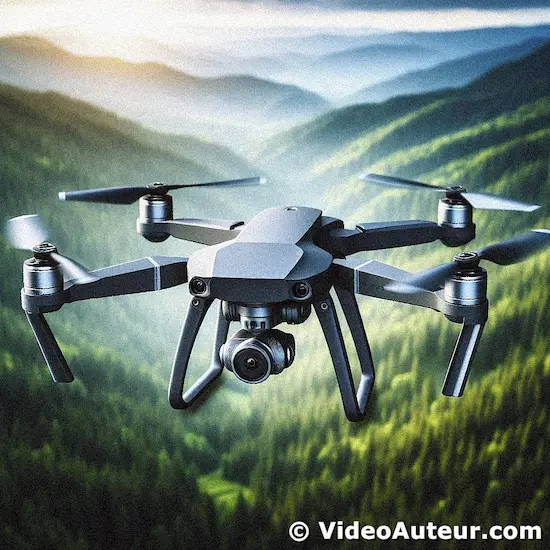 How does a drone work in a video shoot? The way it works involves 3 key things...
How does a drone work in a video shoot? The way it works involves 3 key things...If we are to study how a drone works in a video shoot, it will involve 3 things…
- the drone’s capacity to fly,
- the drone’s capacity to stabilize your shots, and
- the drone’s capacity to shoot videos and images.
—
First, let’s talk about the drone’s capacity to fly…
1. How does a drone work - the drone’s capacity to fly
A drone can fly because of…
- the physical parts that make up the drone itself, and
- the drone’s control system and navigation.
—
A drone is usually made of light materials, so it can easily cruise. Its propellers lift it from the ground.
The common drone that we know moves vertically—meaning,...
- it can take off vertically, and
- it can land vertically.
—
Unlike a toy remote control car, drones need a more advanced system to stay balanced and fly where you want them to. That's where the control system and navigation come in.
And speaking of control, since you'll be the pilot on the ground, you'll have a cool remote control to steer your drone around. That controller normally uses a smartphone, to wirelessly connect to the drone that you operate.
But the drone is not a merely remote-controlled machine. Remember, it has some degree of autonomy. You don’t have to manually control it all the time.
You can also set a flight route for your drone, so that when it flies, it stabilizes itself. It can do that because it's equipped with GPS technology.
—
Next, let’s move on to the drone’s capacity to stabilize your shots…
2. How does a drone work - the drone’s capacity to stabilize your shots
The drone has its own gimbal. The drone gimbal is the camera stabilizer of the drone. It is what enables the drone to give you stable shots, even though the drone is flying.
So, how does a drone gimbal work?
The drone gimbal cancels any vibrations, just like the handheld gimbal. The result is the camera records motion, that's smooth and pleasing to the eyes.
—
Try watching a drone footage. Especially the part where…
- the drone takes off,
- travels first near the ground, then
- slowly reaches higher altitudes.
You get the effect that you’re watching a steadicam shot. And then, it feels like the steadicam operator is also floating through space.
—
A drone gimbal has a part that holds the camera. It also has sensors and motors that keep the camera stable, resulting in smooth shots.
Have you heard about the 3-axis gimbal?
That’s the kind of gimbal that the common drone has. A drone gimbal has 3 motors—very essential for taking professional-looking aerial videos, and photos.
You wish to own a drone? Choose a drone with built-in gimbal and camera.
Why?
Because your video creation life will be easier. The parts of such a drone are already matched with each other. The drone will just fly, shoot videos, and stabilize your shots optimally, as you operate the drone.
—
Now, let’s talk about the drone’s capacity to shoot videos and images…
3. How does a drone work - the drone’s capacity to shoot videos and images
A quadcopter—or the drone that has 4 rotors—has an integrated camera located at the drone's center.
So, how does drone camera work?
In a nutshell, this camera works, when the drone receives signal from the remote control you're operating. You can tell the camera to record videos and take photos. You can also adjust the drone camera settings, using the remote control.
 A drone's remote control.
A drone's remote control.—
Here's some key details of what’s happening…
- The remote control has two joysticks, like those you see on a video game controller. You communicate with the drone, and its camera, using those joysticks.
- A recreational drone may use WiFi for that communication. But, a more professional drone may use other frequencies, which are stronger in signal and more reliable.
- You see what the drone camera sees, from the smartphone attached to the remote control. This is because the drone transmits its camera's “live” 1st person view, to the device you’re holding.
- When you see the video live feed, you feel like you’re riding the drone, though you’re really not. You’re just standing on the ground.
- You can adjust camera exposure, zoom, and other features—depending on how advanced the drone you’re flying.
- To shoot videos or pictures, you simply push the designated button on the remote control.
- The drone’s motherboard receives your signal, and tells the drone camera to capture your desired image—motion or still.
--
Finally, let's put these things altogether: how drones achieve flight, what their basic components are, and how complex they are to operate.
Drones and their mechanics
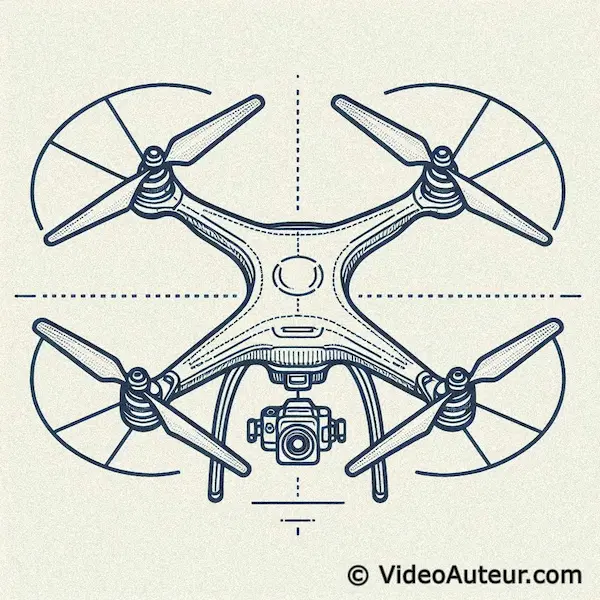 How does a drone work on a fundamental level?
How does a drone work on a fundamental level?Imagine a tiny helicopter controlled by a video game controller. Yes, that's basically a drone in a nutshell!
Helicopters have that one big whopper of a blade, right? Drones are different. They use smaller propellers to zip around. Let's see how the basic components work together to make a drone fly!
Propellers:
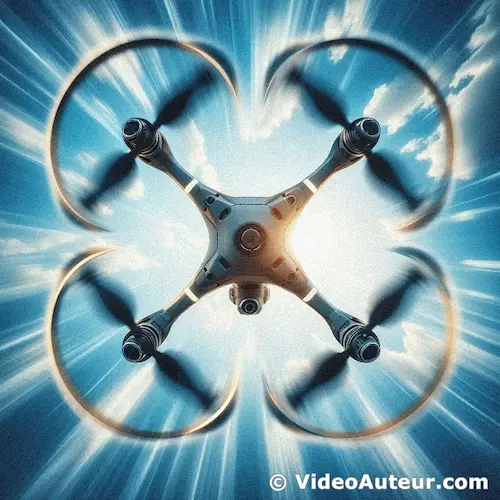
They spin really fast, pushing air downwards, and lifting the drone.
According to a study by Dynotis, since the drone's propeller acts like a wing, "higher blade pitch angle" forces more air down, creating lift.
Motors:
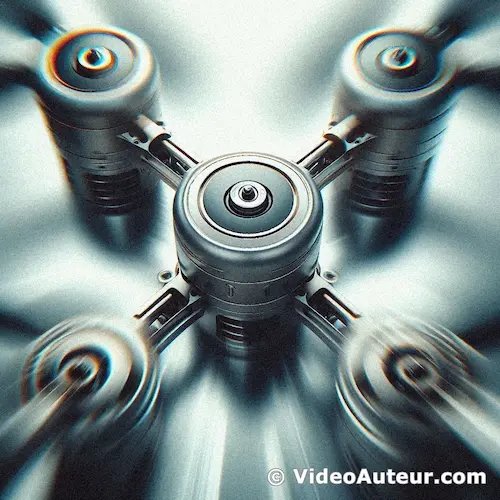
Think of these as the engines of the drone. The battery powers the motors, which spin the propellers.
Flight Controller:
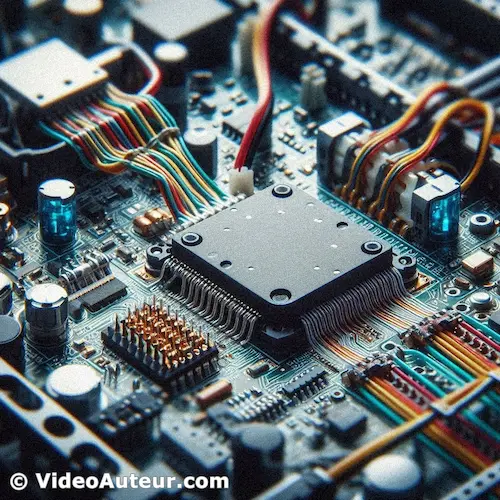
Think of it as the drone's brain -- the central command center.
When you fly a drone, the remote control sends signals to the flight controller.
And guess what? This "brain" has eyes and ears -- its sensors.
These sensors are gyroscopes and accelerometers. They help the flight controller become aware where the drone is, and how it's positioned in space.
Now, here's the fun part...
The flight controller takes all this information and makes split-second decisions. Think of it like a conductor for a drone orchestra! It makes sure all the motors work -- or play ;-) -- in harmony, so the drone can fly smoothly.
So, when you tell your drone to pull off a cool flip or just chill and hover, it’s the flight controller taking care of that. It’s like having a tiny autopilot on board!
Controlling a drone
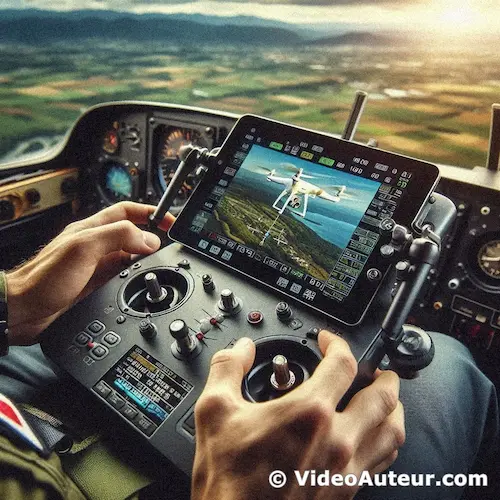 How does a drone work? The way it works isn't magic.
How does a drone work? The way it works isn't magic.Hey! Don't be fooled by those fancy drone videos, flying them isn't magic. It's all about different parts working together seamlessly. Basically, your controller talks to the drone's brain -- the flight controller. Which then tells the motors what to do to move up, down, and all around. Let's break down the controls in a way that's easy to understand.
- Throttle: Controls the overall altitude of the drone. Increase the throttle for a higher ascent and decrease it to descend.
- Pitch and Roll: Imagine tilting a joystick on your controller. The drone is like your head -- tilting it forward, like you're nodding, makes it fly forwards. And tilting it sideways, like you're tilting your head, is how it moves left and right.
- Yaw: It's like the steering wheel of a car. It lets you spin the drone left or right.
Understand these controls. Know how a drone responds. And you'll be ready to snag some incredible aerial shots!
Important note: You know how learning anything new takes time. Right? Well, flying a drone is no different. And be sure to follow the safety rules -- better safe than sorry!
A fellow videographer flew his drone in a place where he didn't bother to check for the restrictions to flying drones. It was a paid video shoot.
As he was flying his drone, he suddenly couldn't control it anymore. He felt he lost communication with his drone, and it fell straight to the ground and broke into pieces. He suspected that there was some sort of signal jammer in the area where he flew his beloved drone.
The lesson? Always fly in open areas away from people and obstacles, and be aware of airspace regulations in your area.
Frequently Asked Questions - How does a drone work?
Do drones require license?
Do drones require license?
It depends on where you are. Are you thinking about flying one in your country?
First, it is important to know why a drone license is necessary.
Basically, it is for safety of the airspace.
Okay, let’s take United States as an example…
—
The US has Federal Aviation Administration—or, FAA.
Let's say you're in the US and want to use your drone for work, like making some extra cash with aerial photography or inspections. The FAA, basically the air traffic control for the US, says you gotta get a license for that.
This license is called a Part 107 certificate, kind of like a commercial drone pilot's license. If you fly your drone for business without one, well, that's illegal. And let me tell you, the fines can sting!
—
However, if you just want to fly your drone for “fun” or recreation, the FAA lets you do that. Even if you don’t have a drone license.
But, there are 3 things the FAA tells you to do…
- Register your drone with them.
- Put the registration number on the body of your drone, clear enough to be seen.
- Bring with you your proof of registration with the FAA, every time you operate your drone.
But beware…
The FAA doesn’t allow you to use your recreational drone’s footage—or photos—to advertise, or promote a business. Even if you don’t get directly paid.
And remember also that in the US, both…
- commercial, and
- recreational
… drones, need to be registered with the FAA.
Is it illegal to use a drone?
Is it illegal to use a drone?
It depends. Where are you in the world?
Here’s another resource—a way for you to visually check the legality of using drones, in different countries.
Note also, there are 2 types of drone laws you need to know, depending on what you want to do with your drone…
- recreational drone laws
- commercial drone laws
—
Let’s use US again as an example…
In the US, it's legal to fly a drone. But, you need to comply with the regulations.
—
Also, there are specific activities that you cannot use your drone for…
For example, you can’t use your drone for hunting wildlife. That’s illegal in 45 out of 50 states in the US.
In addition, even disturbing wildlife by flying your drone, is not permitted by the FAA… especially at national parks.
Of course, don't be that pilot who gets in the way of airplanes and helicopters! Those guys have enough to worry about already. Imagine people's safety inside those aerial vehicles.
How are drones used for videography?
How are drones used for videography?
Drones are equipped with high-resolution cameras and stabilizers that let you shoot smooth, cinematic video from above.
They're perfect for capturing breathtaking aerial shots for movies, real estate, weddings, sports, and creative projects—all previously impossible without expensive gear like helicopters.
Can drones take pictures at night?
Can drones take pictures at night?
Yes! Some modern drones have powerful sensors and features meant for low-light and even night vision.
Many high-quality drones can capture clear photos and videos at night or in dim conditions if you use the right camera settings and equipment (like the DJI Mini 3 or Air 3S).
What do you need for drone videography?
What do you need for drone videography?
At minimum, you'll need:
- A drone with a good camera,
- A stable gimbal for smooth footage,
- Extra batteries and a charger,
- Camera filters for sunny days,
- SD cards for storage, and
- Video editing software for polishing your footage.
Is it difficult to fly a drone?
Is it difficult to fly a drone?
Flying a drone is challenging at first, especially if you haven’t used remote-control devices.
Many beginners need practice and sometimes benefit from flight simulator apps before flying for real. With time, it gets easier, but there’s a learning curve at the start.
How long does a drone battery last?
How long does a drone battery last?
Most consumer drones stay airborne for 15–30 minutes on a single charge.
High-end or professional drones might last up to an hour, while specialized industrial drones (rare for video beginners) can even go beyond that.
Wind, flight speed, and camera use affect battery life.
Can a drone fly for 2 hours?
Can a drone fly for 2 hours?
It’s rare. Only some industrial-grade or fixed-wing drones designed for mapping, surveying, or delivery can fly for 2 hours (or more).
Typical video/photography drones fall well short—most max out at 30–45 minutes per flight.
What happens if a drone battery dies while flying?
What happens if a drone battery dies while flying?
Most modern drones have “return to home” or auto-landing features that kick in when the battery is low. But if a battery is fully depleted mid-air and the drone isn’t programmed to land, it can crash abruptly.
What is the lifespan of a drone battery?
What is the lifespan of a drone battery?
Most drone batteries (especially LiPo and Li-ion types) last for about 150–500 charge cycles, or roughly 1–3 years depending on use and care.
Keeping batteries charged properly and stored safely extends their life.
Can drones fly in the rain, and why is water a risk?
Can drones fly in the rain, and why is water a risk?
Most standard drones are not waterproof. Flying in rain risks short-circuiting electronics and corroding motors, which can lead to total failure or crash.
Always avoid flight in wet weather unless you have a drone rated as water-resistant.
What can damage a drone?
What can damage a drone?
Common risks include crashes, water exposure, flying in strong winds, over-discharging batteries, and physical impacts.
Propellers are fragile and easily break, and a bad landing can damage cameras or sensors.
What are the key safety rules and things to avoid when flying a drone?
What are the key safety rules and things to avoid when flying a drone?
- Always check local laws and airspace restrictions.
- Keep your drone in sight.
- Don’t fly over crowds or private property without permission.
- Avoid airports and aircraft at all costs.
- Don’t fly in bad weather.
- Land with plenty of battery left.
- Don’t take off without a pre-flight check.
Stick to these “do’s” and avoid the “don’ts” for safe flights.
Can you fly a drone at night?
Can you fly a drone at night?
You can—if you follow local rules. Some regions require extra permissions, anti-collision lights, or night pilot training.
Always check your country’s law before flying after sunset.
Are people allowed to fly drones around your house?
Are people allowed to fly drones around your house?
This depends on local privacy and airspace laws. In many places, flying over private property without permission is discouraged or outright illegal, especially if recording video.
Check your country’s and area’s specific rules.
What happens if a drone hits an airplane?
What happens if a drone hits an airplane?
A mid-air collision with an airplane is extremely dangerous—it could result in injuries or a crash. That’s why all aviation authorities strictly forbid flying drones near airports or at high altitudes.
Breaking these rules leads to legal penalties and puts lives at risk.
Is it worth buying a cheap drone?
Is it worth buying a cheap drone?
Cheap drones can be great for getting basic flying experience or learning the controls, but they often have less stability, lower camera quality, and shorter battery life.
If you’re serious about videography, investing in a mid-range or high-end drone will pay off in smoother footage and reliability.
Conclusion - How does a drone work in a video shoot?
So, you just read about how awesome drone videography can be. Let's break it down into the cool stuff:
- Wow your friends with mind-blowing views! Ever wished you could get that perfect picture of a mountain range, or show off a cool building from a crazy angle? Regular cameras can't get that far, but drones can - they're like having your own personal flying cameraman!
- Hollywood on a budget: Forget expensive helicopters! Forget fancy cameras! Drones can level up your videos to look amazing, all without costing a fortune!
- Forget what you think about drones being hard to fly. These things are getting super user-friendly. Even as a beginner, with a little practice, you can be capturing stunning footage that'll make you look like a pro!
- Drones are like little flying film crews! Drones can fly practically anywhere. Weave through narrow gaps, skim the ground for cool low-angle shots, or climb super high for epic views. They open up a whole world of cool possibilities for your videos.
One quick thing before you get started - there are a few important points to consider.
- Safety first! Fly in open areas, stay away from people and objects, and always check airspace regulations.
- Do you need a license? Rules for drones vary depending on where you live. Check before you fly!
- Heads up about drone laws! There might be rules about where you can fly one, especially if you're using it for work or buzzing any animals.
Safe flying and awesome drone videos? These tips got you covered.
Now, the fun part! What kind of video can you imagine using drone footage in?
Check out this topic related to drones...






